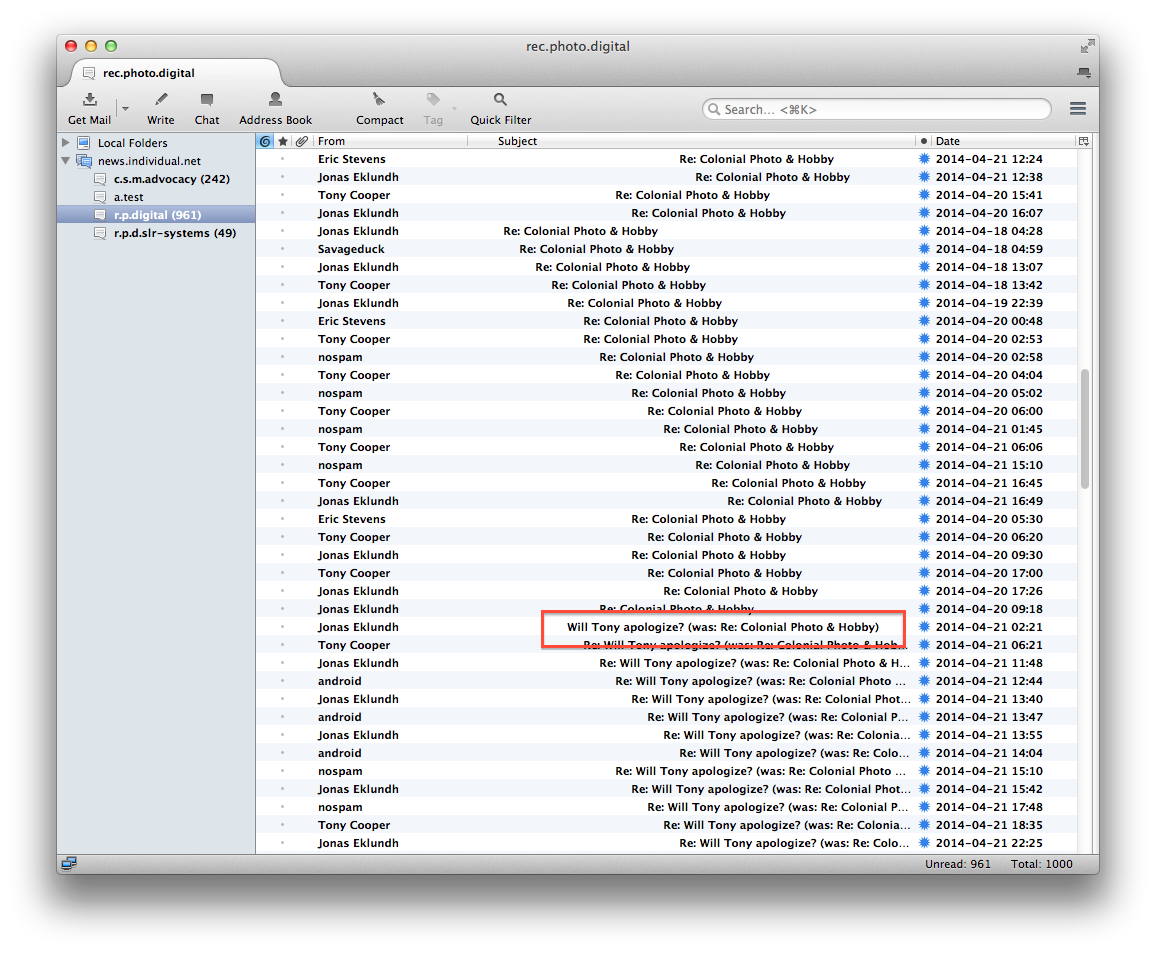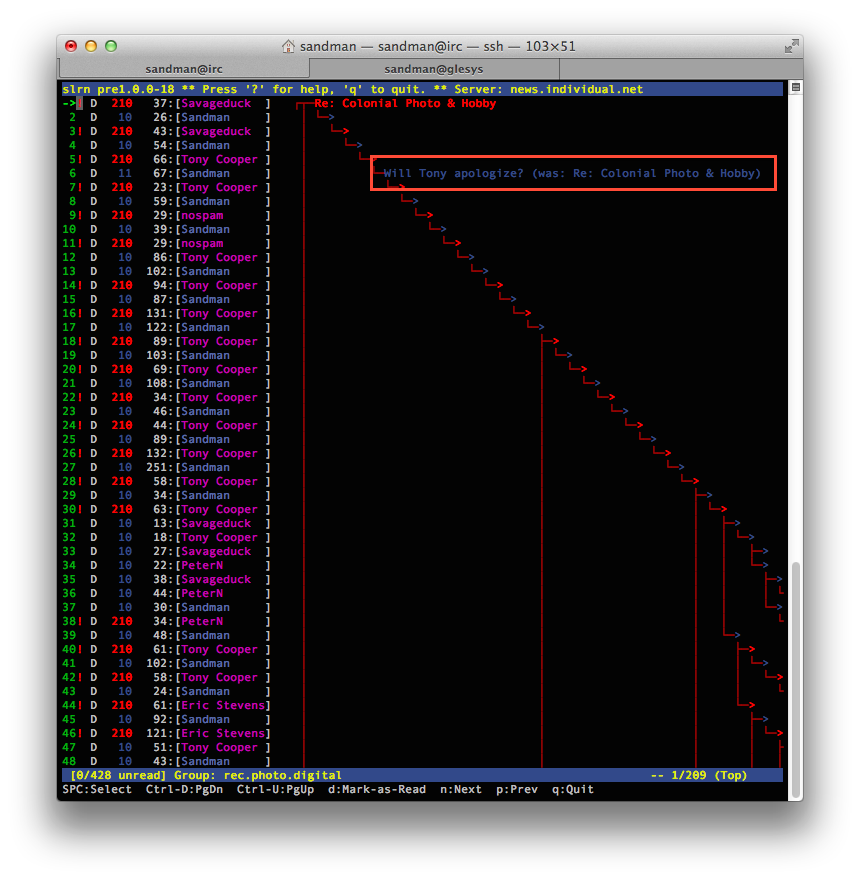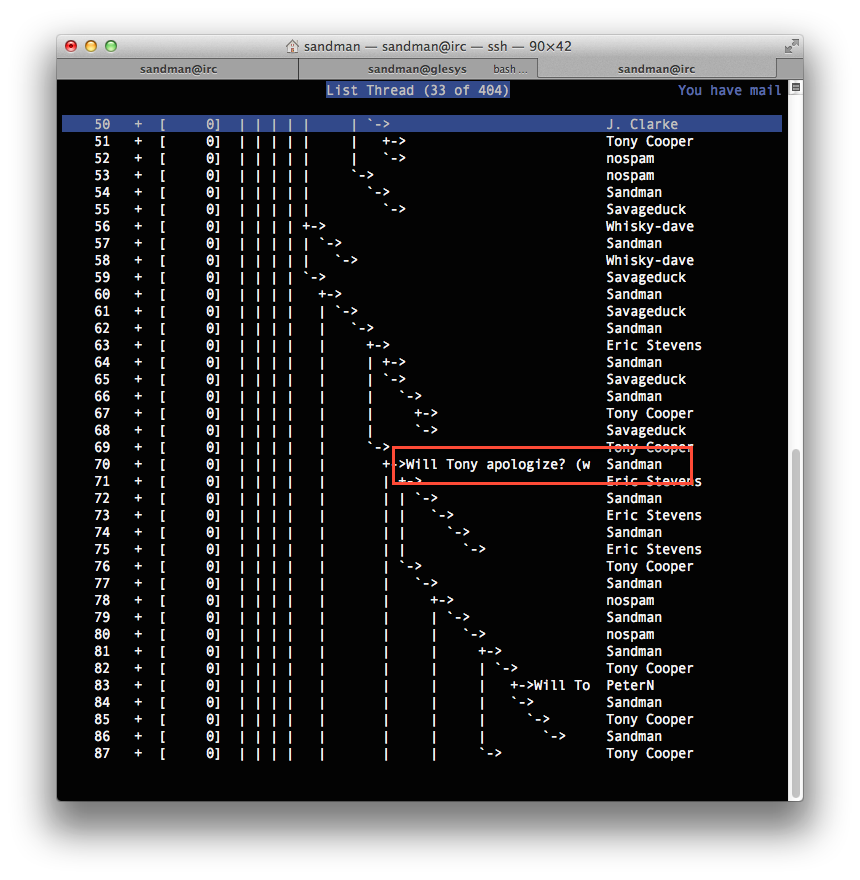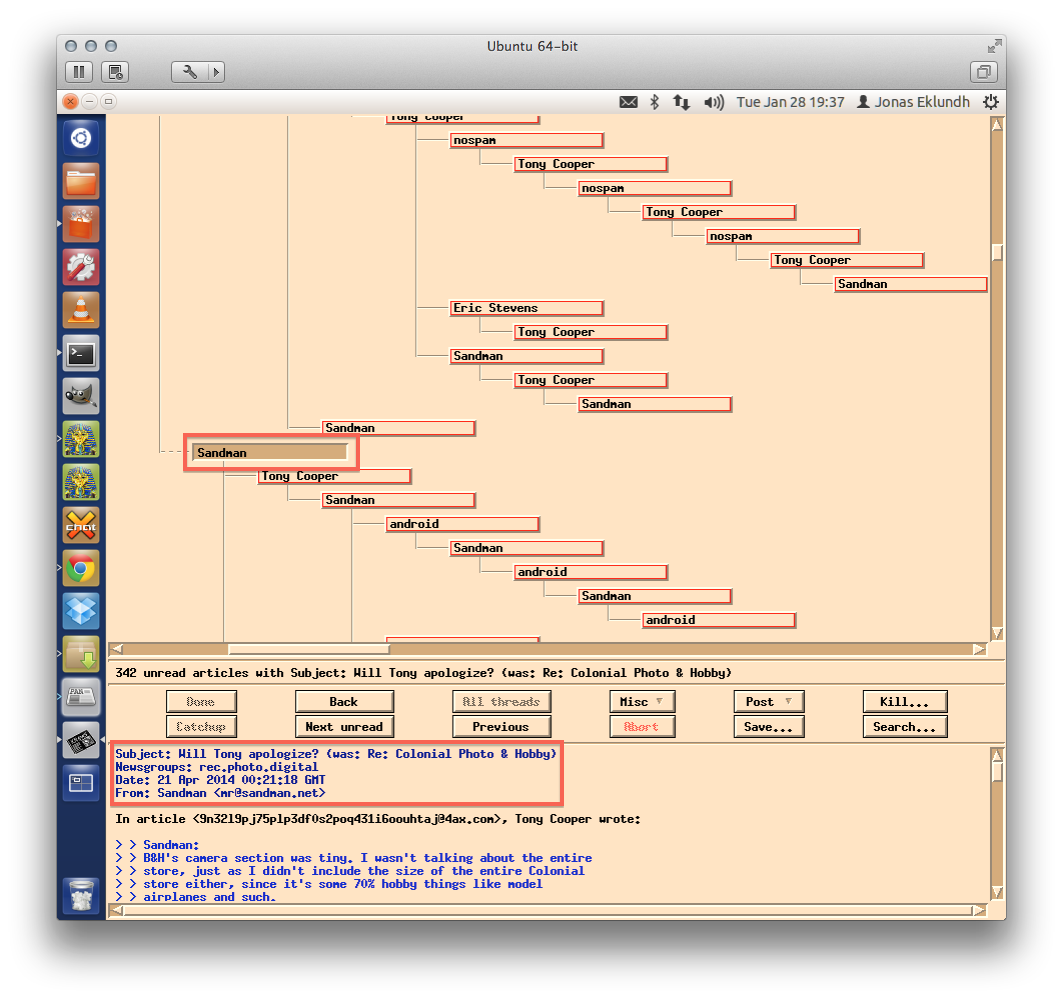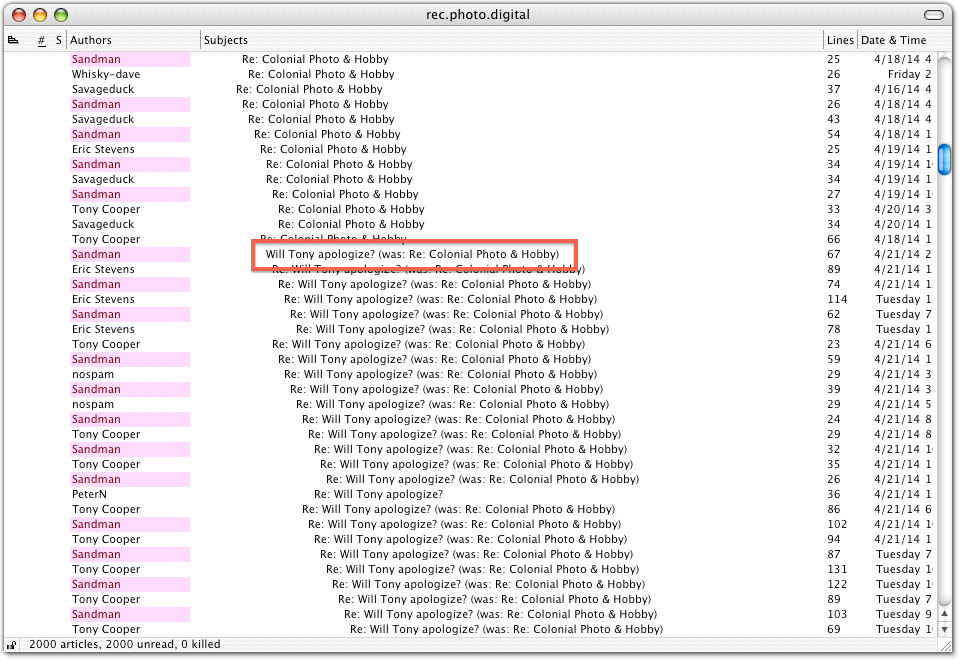Re: Will Tony apologize? (w...
Eric Stevens| Subject | Re: Will Tony apologize? (was: Re: Colonial Photo & Hobby) |
| From | Eric Stevens |
| Date | 05/03/2014 01:23 (05/03/2014 11:23) |
| Message-ID | <ic88m95686fjpno6i2ia5ht5seehk0uhak@4ax.com> |
| Client | |
| Newsgroups | rec.photo.digital |
| Follows | Sandman |
| Followups | Sandman (10h & 48m) > Eric Stevens |
On 2 May 2014 09:23:45 GMT, Sandman <mr@sandman.net>wrote:
SandmanYou don't learn anything from the past. You repeat the same falsified claims. You fail the Turing test at almost every level.
In article <o6m6m959jqstvicndf42guuolb3in2ehd5@4ax.com>, Eric Stevens wrote:SandmanSandmanEric StevensSandman<Eric Stevens> <
> <
> <
> <
> <
> <
> <
>
Then there is Agent which you ignored: https://dl.dropboxusercontent.com/u/31088803/Agent%20Thread.jpg
I didn't ignore it. I am showing how the standard way to display threads is done, and how Agent is non-standard.
You are? Where can I watch?
There are none so blind as those who will not see.All support is quoted above.Eric Stevens
*All*? There are no possible ways of doing things other than the ways displayed in the examples you have cited above?
Of course not. There are a multitude of news reader out there and I don't have access to them all for obvious reasons.
I said there was a standard way of displaying hierarchies that is also in compliance with the RFC. You questioned that claim and I showed eight news clients, most of which are the most used news clients on usenet today (see my earlier post about usage stats).
That doesn't PROVE that this is the standard way to show threads, but it SUPPORTS the claim, seeing how we have only ONE examples of a client that by default threads in a non-conforming way, and at least eight that does.
So, currently, Agent is outnumbered by 8-1, which certainly substantiates the claim that there exists a standard and Agent is not following it.
If you were to show me seven more news clients that does it the way Agent does it, then we have a "draw" as far as support comes, and I would either have to concede that it's not a standard, or find an order of magnitude more clients that does it the correct way.
See, you can't "counter" my examples with the allusion that there might possibly be other clients that does it the way Agent does it.
I made a claim and I supported it thoroughly. I do enjoy supporting my claims to a point where they can't be disputed, but I don't have the time, or access, to every single news client in the world - and unless you can come up with a good counter example, there is no need for me to do so.
Which do you think most people will want to: follow the reference list or follow the thread?SandmanEric StevensSandmanYou keep saying that, without support. Most readers have standard news clients that does NOT (I repeat - NOT) separate a post when the subject is changed, and honor the sequence of articles as stated in the headers. Your claim is based on "the reader" being only users of one of the worst news clients known to man - Agent.Eric Stevens
My claim is based on readers being people who want to follow particular subjects and not follow others.
But the question isn't about whether or not people want to "follow particular subjects", but about what constitutes a thread.
It is possible they are the same thing.
But in this case they aren't, as I have shown.
You have referred me to an article written by a person (Peter de Silva) which has no authority as a standard or reference. This in turn refers the reader to a number of links, one of which is to draft proposal "Usenet Best Practice" written by C.H. Lindsey in 2005. This has a lengthy section on threading. The relevant text may be found in Section '3.3.2.1 Threading' at http://www.eyrie.org/~eagle/usefor/drafts/draft-ietf-usefor-useage-01.txtSandmanAnyway, you've been clamoring for more references, and I've instead tried to make you explain your own claims and thought that when you tried to do it, you would have understood by yourself how they're not working.Take a look at section 2.2.5 of RFC 1036. I'll quote it here:Eric Stevens
Do you *really* want to quote an RFC which dates back 27 years:
This is usenet, Eric. It's a really really old protocol. Yes, all of this was in place back in 1987. Which makes it rather ironic that AgentEric StevensSandman
a document for which steps were taken to supplant in 1997? See https://groups.google.com/forum/#!msg/news.software.misc/-vJ2XG06W3k/LP4GQB_DHyEJ
The changes that have been suggested over the years have never been about the References header and its use.Eric Stevens
See also http://www.eyrie.org/~eagle/usefor/
Begin quote: ------------------------------------------------------------------------ Reading agents SHOULD present the articles in each newsgroup in an order which ensures that the reader never sees a followup or reply to an article unless he has already had an opportunity to read the original. However, this may be easier said than done. Here are some methods commonly used to fulfil this aim; none of them works perfectly.
1. Present the articles in the order they were received at the local serving agent. However, articles propagated via different routes with different delays may well arrive out of order, so this may not be reliable.
2. Sort the articles into order according to their Date headers. This will usually be better than the first method, but relies on the clock and timezone settings in posting agents being approximately correct. And although it satisfies the minimal recommendation at the head of this section, it will likely result in totally separate threads of discussion being merged in an unhelpful order.
3. Sort the articles according to their Subject headers (or group them according to their Subject headers, with the groups being presented in order of the Date header of the first article in each group). Within a group with the same Subject, sort according to the Date header. This works tolerably well, but within a long discussion with many divergent subthreads, those subthreads are still merged in an unhelpful order. Moreover, it will occasionally bring together totally unrelated articles that just happen to have the same Subject by chance.
4. Construct a tree in which each article is within a sub-tree headed by each article mentioned in its References header, and present articles by a depth-first traversal of that tree, sorting the siblings within each branch according to their Date headers. This method is usually superior to the ones mentioned earlier, but it can go wrong for a number of reasons.
C. H. Lindsey [Page 21] Usenet Best Practice March 2005
a) References headers are sometimes absent, or incomplete (and are even permitted to be trimmed when they get too long), and earlier articles in the threads may have expired off the local server. Nevertheless, with careful implementation, these problems are mostly surmountable.
b) A poster may join an existing discussion (and clearly intend to do so by using the same Subject header, possibly with a prepended "Re: ") and yet his article might not be created as a followup to any specific precursor and hence would not have a References header. Hence it would be presented quite apart from the other (sub-)threads of that discussion.
c) Conversely, the topic of some sub-thread might have diverged so far from the original topic of discussion that some poster decides to create a totally new Subject for his followup. Nevertheless, that followup, and the whole sub- thread which issues from it, will still be presented in the midst of the other sub-threads of the original discussion.
5. To counter these various deficiences, various hybrid schemes have been devised which take account of all three headers, References, Subject and Date, and these often succeed in providing a more pleasing presentation to the reader. However, different readers can be pleased in different ways, and so it is often the case that reading agents provide configurable options to choose between several methods.
This document does not single out any particular method as "the best". They are all to be considered acceptable, and implementors are encouraged to experiment accordingly. Nevertheless, it is inevitable that some combination of Subjects and followups will eventually arise that defeats even the most sophisticated scheme.
It must be noted, however, in the case of those methods which rely on the comparison of Subject headers, whether to detect equality or for sorting, that there are certain additional precautions that need to be taken, such as:
a) [USEPRO] permits a back-reference "Re: " to be prepended (optionally) to a Subject when creating a followup. Therefore, that back-reference SHOULD be stripped away before performing any comparison of Subjects. On the other hand, "Re:" is the only back-reference permitted, and therefore it is not necessary for translations of "Re: " into other languages to be recognized (even though such translations are sometimes generated by non-compliant followup agents). Likewise, that "Re: " is case-sensitive, although non-compliant agents that generate "RE: " are common enough that it might be wiser to accept that form also.
b) It is not unknown for non-compliant followup agents to truncate the Subject header. Some reading agents therefore truncate the Subject before making any comparison. Sometimes this makes things better; sometimes it makes them worse.
c) The use of <encoded-word>s ([RFC 2047]) within Subject headers can give rise to different ways of encoding the same Subject. Therefore, such encoding SHOULD be undone before any comparison of Subject headers is made. It cannot even be assumed that the back- reference "Re: " is not within an <encoded-word>.
------------------------------------------------------------------------ End quote
NOW tell me there is a standard format.
---<discussion of obsolete issues snipped >--- --
Regards,
Eric Stevens
Sandman (10h & 48m) > Eric Stevens
